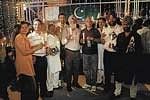
Peaceniks from India and Pakistan appear to be a determined lot. Despite frequent roadblocks and setbacks to their mission in the wake of cataclysmic events like 26/11 attack in Mumbai and attack on the Indian Parliament in 2001, they chug along undeterred, hoping that love and friendship would ultimately trump mutual animosities and prejudices.
One ritual that has become symbolic of the unbounded optimism of the peaceniks from both sides is the candle-light vigil at the Wagah-Attari border gates every year on the night intervening August 14 and August 15 when the two countries celebrate their Independence Day. The ritual has sustained for 13 years regardless of the status of relationship between the two countries under the aegis of the Hind-Pak Dosti Manch propagated by noted journalist, Kuldip Nayyar and Satnam Manak.
Candlelight vigil
For the past two years, intellectuals, human rights activists and journalists under the aegis of South Asian Free Media Association (SAFMA) have been reciprocating the the candlelight vigil on the Wagah side. This year, a seven-member delegation of Indian journalists led by Chanchal Manohar Singh participated in the hour-long midnight candlelight vigil at the Wagah. On the Indian side, a 17-member delegation from Pakistan, including the SAFMA secretary general, Imtiaz Alam, participated in the vigil along with Indian peace activists including Nayyar and film producer, Mahesh Bhatt.
Slogans like “Hind Pak Dosti Zindabad”, “Down with terrorism” were raised on both sides of the border in an electrifying atmosphere brought alive by coronas of hundreds of lit candles.
Manu Bhai from the SAFMA who led the candlelight vigil on the Pakistan side, said, “there should be vigorous people-to-people contact between the two countries for better mutual understanding and harmony.” He said both countries have one common enemy which is terrorism. “More cooperation is needed to deal with this common enemy,” he added. The head of the Indian delegation, Chanchal Manohar Singh said, “let us rise above hatred and misunderstandings and reach out to each other. We do not want war; peace alone can ensure development of both nations.” There was a chorus of Hindustan Zindabad slogans from Pakistani delegates, an unprecedented gesture on the other side of the border. On the Indian side, Nayyar said, “Candle light vigil is a symbolic gesture of unity, as it gives a wakeup call to both governments to diminish enmity and get on with the business, like two good neighbours.” He said hassle-free visa regime would enhance people-to-people contact between the two countries.
Iqbal Hyder, a member of Pakistan National Assembly, who lit candles on the Indian side, said about the only surviving and captured terrorist of 26/11, “Ajmal Kasab is not only your enemy, he is our enemy too.” Peaceniks on both sides admit that their job becomes all the more difficult in the wake of incidents like Mumbai attacks. “It becomes difficult to talk of peace in the charged atmosphere,” said Saeeda Diep, who heads the community-run Institute of Peace and Secular Studies at Lahore. At a dinner hosted for the Indian delegation, she said anyone coming from India was welcome to live at her house. The peace activists on both sides demand relaxation of visa regime for allowing easy access for common people to visit each other, a common tourism policy that would boost the region’s economy and a free trade agreement to encourage bilateral trade flows.
“We should have a pan- South Asian perspective. The SAARC has to play a more active role and proceed on the lines of the European Union,” says Imtiaz Alam, secretary general, SAFMA. He said the two countries should have a new paradigm of partnership and friendship by getting rid of the mindset of animosity.
Citizen diplomacy
The high point of track two diplomacy was the people to people interaction witnessed during the 2004-05 Indo-Pak cricket series. People in Lahore talk fondly about that series when Pakistanis vied with each other to host and treat about 3000 cricket fans from India in an unprecedented exhibition of bonhomie. It was the height of citizens diplomacy. In the ever-changing contours of relationship between the two countries, it is the peaceniks who provide a semblance of sanity amidst recurring hate-rhetoric and hold a glimmer of hope for a lasting peace between the two countries.